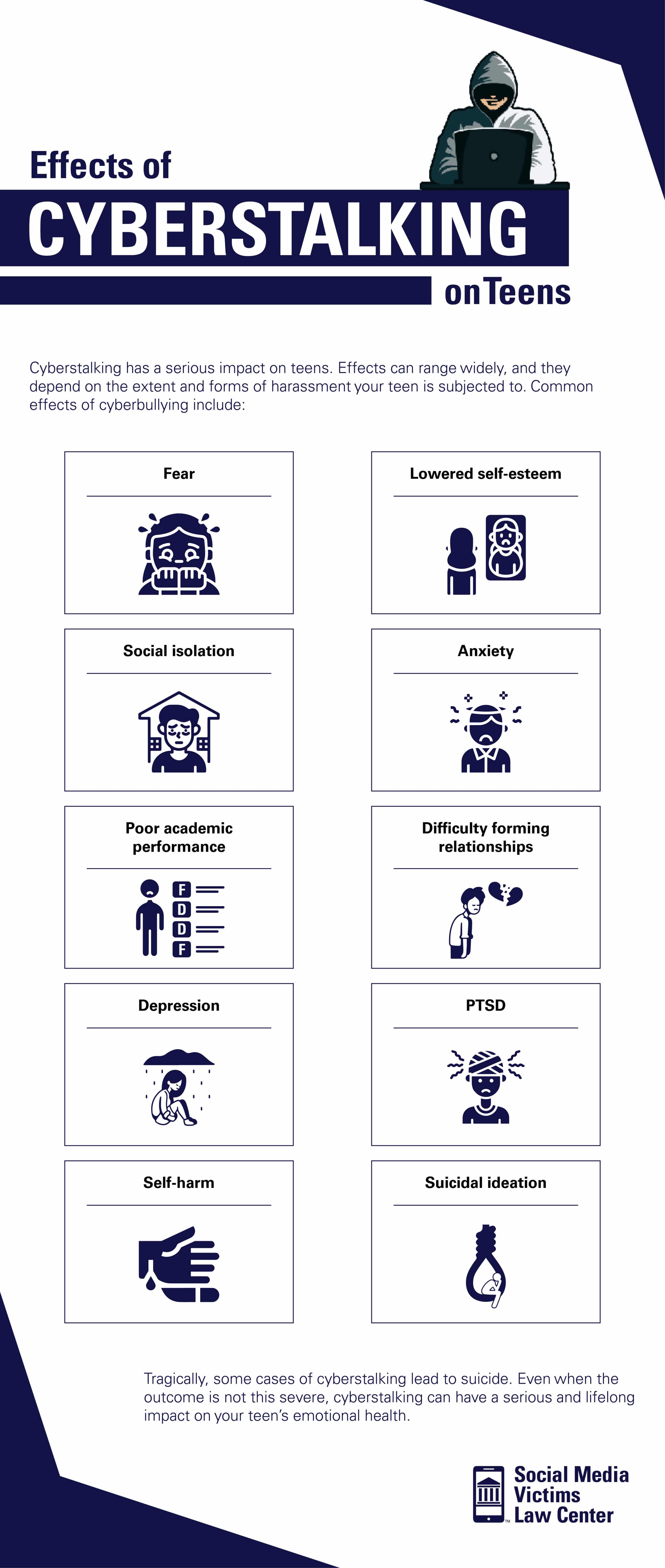What is Cyberstalking?
Cyberstalking is a form of online harassment in which someone threatens, intimidates, or tries to control another person. Teenagers are at an especially high risk of falling victim to cyberstalking.
 Written and edited by our team of expert legal content writers and reviewed and approved by Attorney Matthew Bergman
Written and edited by our team of expert legal content writers and reviewed and approved by Attorney Matthew Bergman
- Content last updated on:
- June 12, 2025
Written and edited by our team of expert legal content writers and reviewed and approved by

- Content last updated on:
- June 12, 2025
Some cyberstalkers simply aim to cause emotional distress to their victims through cyberbullying. Other times, the danger is far higher.
Cyberstalking can result in someone tracking your teen’s location, extorting sexual photographs, or even compelling them to meet up in person. In the most extreme cases, cyberstalking can tragically lead to human trafficking or death.
Parenting in the age of online networking and social media presents new and unique challenges. Parents should stay informed and speak to their children about online predators. If your child or teen has phone or internet access, you need to take precautions to keep them safe online.
Is your child the victim of cyberstalking? An attorney can help you understand your options.
Cyberstalking vs. Cyberbullying
Cyberstalking is a type of cyberbullying. It’s often perpetrated by an older or more experienced online user targeting a specific victim. Generally, cyberstalking is premeditated and purposeful, while cyberbullying is more erratic and unpredictable or unplanned.
Cyberstalking happens when an electronic medium like a phone, email, social media site, or message board is used to harass, harm, or create fear in another. These tactics are usually done out of anger or a desire for control or revenge. One particular story to come out of Florida involved an armed cyberstalker showing up at a teen’s house after harassing her on her TikTok account.
Cyberbullying might include similar actions, but often lacks a specific motive. Instead, it’s often done out of spite. Cyberbullying is much more common than cyberstalking. It happens when a child is the victim of harassment, threats, intimidation, or intentional embarrassment on an online platform. To count as cyberbullying, the actions need to be hostile, intentional, and recurring.
Although both cyberbullying and cyberstalking can be carried out by either a child or an adult, cyberstalking for purposes of control and coercion is more likely to come from an adult abuser, but it frequently happens among teens as well. When the actions are severe enough, offending teens can find themselves facing criminal cyberstalking charges.
Examples of Cyberstalking
Cyberstalking takes many forms. The most common forms of cyberstalking involve the harassment of another, often through social media. Actions that are considered to be cyberstalking include:
- Sending excessive, abusive, or threatening texts or emails
- Posting or threatening to post nude photos or explicit videos
- Contacting the victim through a fake social media account
- Posting slander or false accusations online
- Encouraging harassment of the victim by others
- Monitoring the location and activities of the victim
Cyberstalking can also involve hacking into another person’s online accounts to:
- Learn personal information
- Steal data or explicit materials
- Pretend to be a victim
- Post malicious comments or threats
These are some of the most common tactics used by cyberstalkers. If an online behavior is recurrent and intended to harass or stalk the victim, legal recourse is likely available under cyberstalking laws.

Prevalence of Cyberstalking: Is your teen at risk?
Schools increasingly make use of online learning features, which means that more children than ever are online with little or no supervision and open access to the internet.
The prevalence of cyberstalking continues to rise, and the growing numbers of naive children and teens online result in easy victims.
The best way to prevent the risk of cyberstalking is to talk to your kids about the dangers of online communication. Monitor the online activities of younger children and have honest conversations with teens about the threat of online predators.
Effects of Cyberstalking on Teens
Cyberstalking has a serious impact on teens. Effects can range widely, and they depend on the extent and forms of harassment your teen is subjected to. Common effects of cyberbullying include:
- Fear
- Lowered self-esteem
- Social isolation
- Poor academic performance
- Difficulty forming relationships
- Anxiety
- Depression
- PTSD
- Self-harm
- Suicidal ideation
Tragically, some cases of cyberstalking lead to suicide. Even when the outcome is not this severe, cyberstalking can have a serious and lifelong impact on your teen’s emotional health.

Protecting Your Teen Online: How can I prevent cyberstalking?
Establishing a basic online safety protocol for your teen is the best way to keep them safe online.
Encourage your teen to keep public location settings turned off on social media apps. Teach them to refrain from posting personal information on their accounts, like a phone number, school, or home address.
Make sure your teen understands the dangers of speaking to strangers on the internet and the risks of taking or sending explicit videos and photos of themselves.
Finally, the best way to prevent cyberstalking is to make sure they know they can come to you for help. One of the saddest aspects of cyberstalking is it often goes much further than it should because teens are afraid to come to their parents with the truth.
It’s hard for a teenager to admit to mom and dad that they took and sent explicit photos or they’ve developed a relationship with a stranger on the internet despite knowing it was unsafe.
All too often, parents react with anger, disappointment, and punishments like taking away a teen’s phone or internet access. When teens are afraid of parental reactions, they don’t come forward and ask for help.
Protecting your teens means talking to them and making sure they understand that it’s okay to come to you with these types of serious issues. When teens see that their parents are willing to help rather than punish, they’re much more likely to ask for help when they need it.

What if cyberstalking is already occurring?
If you suspect that cyberstalking is already occurring with your teen, take action before it goes further. Look for signs like altered behavior, isolation, and depression. Have an open conversation and let them know you can help.
Relieving a teen’s fear of anger or punishment can go a long way toward getting them to open up to you.
Cyberstalking is illegal. If you’ve confirmed that cyberstalking is happening, legal recourse is possible. Take screenshots and save any other forms of evidence as documentation, and report the cyberstalking to the police.
Cyberstalking Laws
Cyberstalking is a federal crime. It was first criminalized as a stalking statute in the Violence Against Women Act of 2005 and later amended in 2013 to include activities via phone and internet.
As federal law currently stands, cyberstalking is the use of a computer or electronic communication device for the purpose of creating fear of death or injury or causing substantial emotional distress.
A cyberstalking conviction can be accompanied by up to five years in prison and a $250,000 fine. Cyberstalking can result in a lifelong prison sentence if the actions resulted in the victim’s death.
Cybercrimes are a relatively new area of law, and regulations continue to evolve. A specific cybercrime of growing concern is the threat of sextortion.
Sextortion is the act of threatening to release private or sexual images or videos of the victim unless certain demands are met. Oftentimes, these demands are for further sexual favors and images, but the goal can also be to extort money or other actions from the victim.
Teens are at high risk of falling victim to sextortion because they’re often afraid to ask adults for help due to the sensitive nature of the explicit images involved.
Currently, sextortion falls under cyberstalking laws. As cybercrime laws continue to develop, unique laws and penalties targeting the increasingly common practice of sextortion will likely develop as well.
Social media and technology have created serious vulnerabilities that put children and teens in danger. You can protect your children from internet crimes by educating them and knowing what to do when they occur. If you believe your child has already been harmed by the effects of social media, please contact us for a free consultation.
Frequently Asked Questions
For individuals and children who have been
We only handle cases on a contingent fee basis. This means that we are paid a portion of any recovery obtained in the case and you do not owe us any attorneys’ fees if the lawsuit does not result in a recovery.
Every case is unique. Our attorneys will work with your family to evaluate your potential case and help you evaluate whether filing a lawsuit or other legal proceeding is in your family’s best interest. Generally speaking, the types of cases we handle involve serious mental health effects, including attempted or completed suicide, eating disorders, inpatient mental health treatment, or sexual trafficking/exploitation that was caused by or contributed to through addictive or problematic social media use by teens and young adults.
We are a law firm based near Seattle, WA comprised of lawyers who have spent their entire careers representing victims who have been harmed by dangerous products. We are also parents. Shocked and troubled by the recent revelations about the harm caused to teens and young adults by social media platforms, which powerful technology companies have designed to be highly addictive, Social Media Victims Law Center was launched specifically to help families and children who have suffered serious mental harm or exploitation through social media use to obtain justice.
Contact Us Today
Related Pages
Client Testimonials
Explore Popular Topics

Addiction

Suicide

Eating Disorders

Anxiety

Bullying

Sexual Abuse

Body Image

